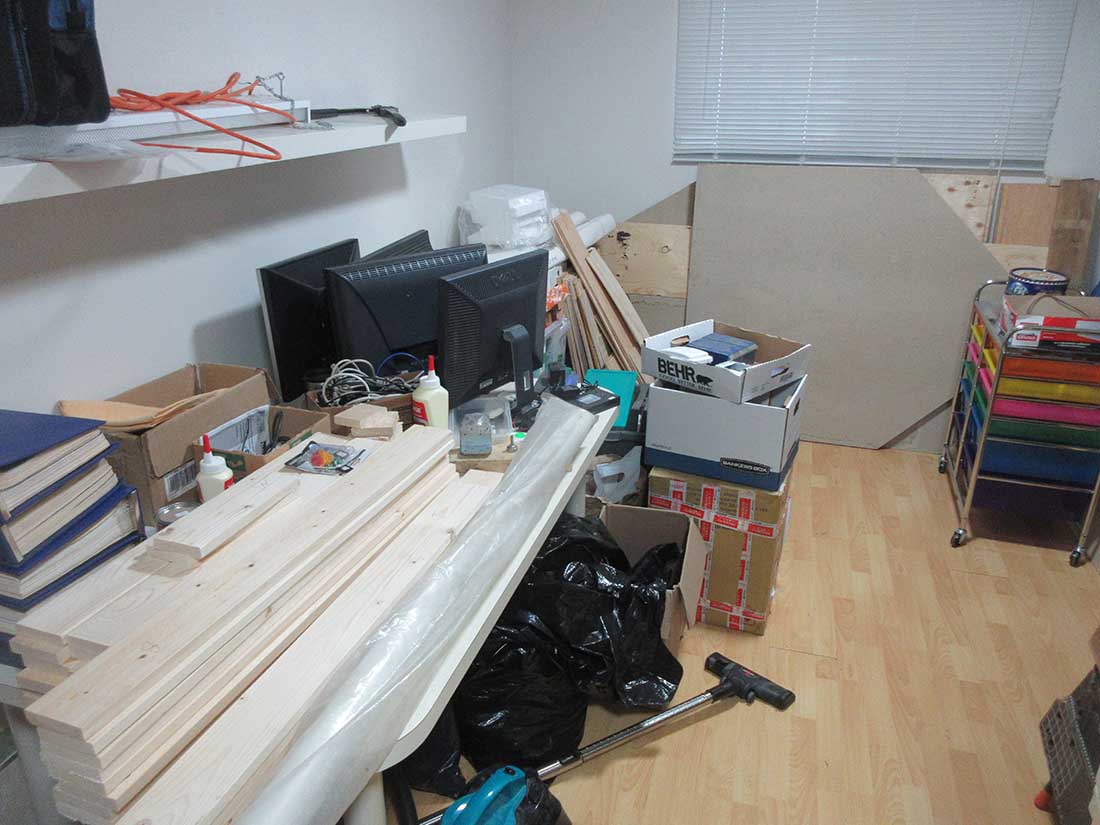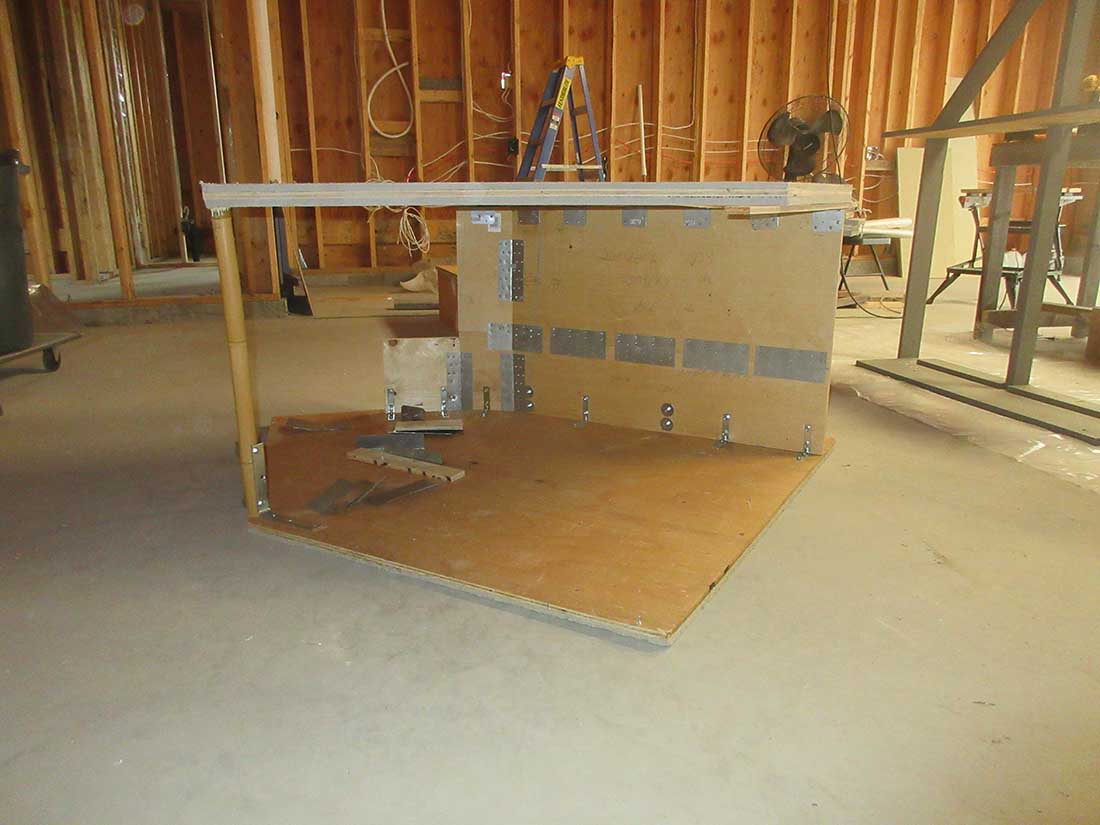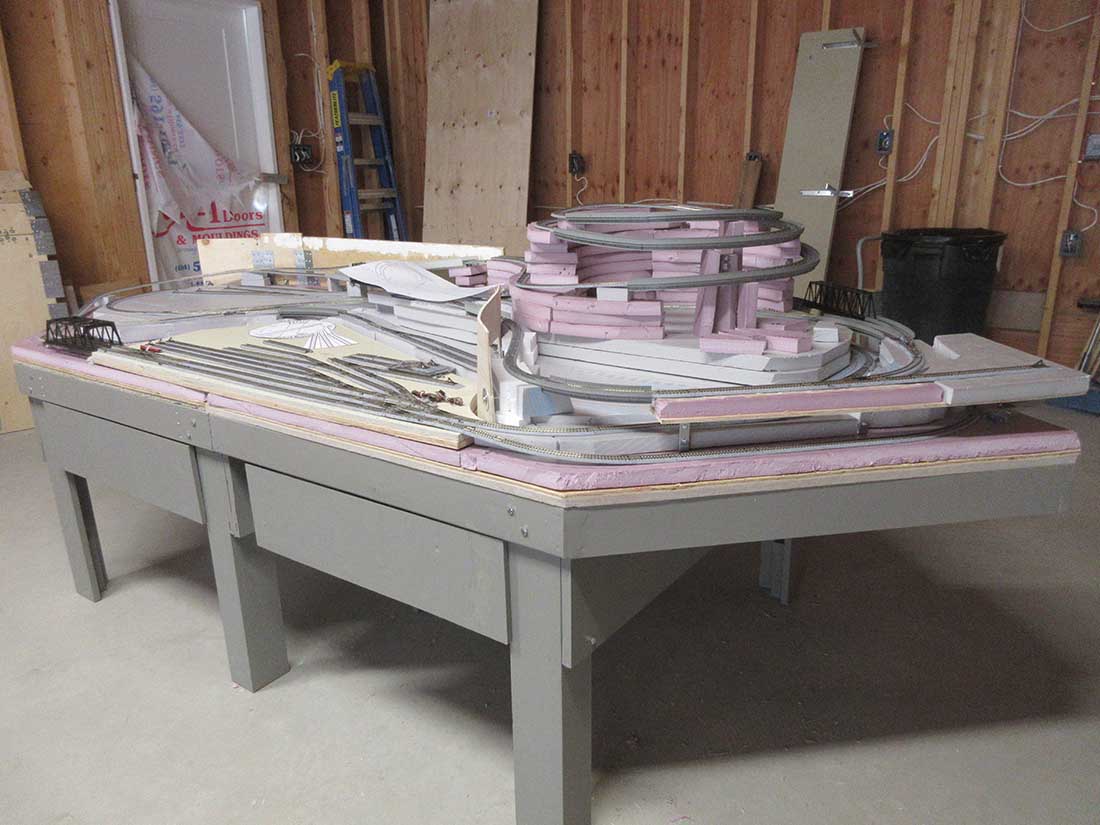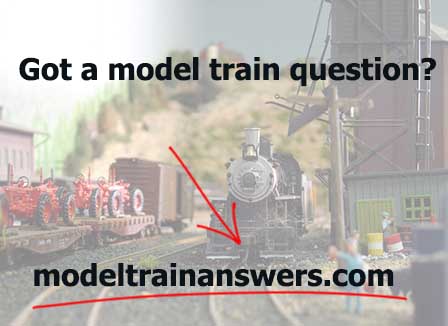Frank’s been in touch again – this time he’s been busy laying model railroad track on foam:
“Hello Al, Frank again from the West Coast of North America.
We have had a very cold (for here) winter, so nothing new is being done, however, you mentioned in a recent blog, "Looking at one hell of a mess and then scratching your head over wiring is all part of the process.
Every layout you have ever seen, at one point, was a rat’s nest of wires, tools, track and profanities." I had not sent you many pictures of the "before", but considering your comment, here are a few.
In June the table parts were cut and stacked ready to be assembled. That was the point that I realized that although the room would hold the finished table, there wasn't enough room to build it!
This is the first table assembled with the original (homosote base) Winterburg module being glued. The down grade cut is just visible along the near side edge.
The next shows the electronic bays after painting. Here again, I have to thank one of your readers for the idea of using grey paint. The supports are the tall pieces with the open bottom.
The Winterburg support had to be built before any foam went onto the table as it had to be firmly bolted to the table frame.
Laying model railroad track on foam:
A keen observer will note that the bolts holding the center rectangular plates to the top part are on the upper part of the plate. To prevent the plates from being damaged in a move, the bolts were later moved to the lower part of the plate so that the module could sit on the ground.
The front temporary support, a piece of bamboo from a friend's garde) was later replaced with a 1 inch acrylic rod, which is almost unnoticeable.
Next, was my fhe first attempt at putting track onto the table. This was when I discovered that the paper template I had originally used was just a little bit bigger than the actual table. This is actually all 4 layers plus the spiral, flattened out just to see if it would fit. This was also the time that the Away Yard shrank from 3 to 2 tracks and the additional yard became necessary.
Laying model railroad track on foam:
During the early construction, I decided to see what the spiral would look like and how it would impact the logging area. The viaduct supports are a lot bigger than the finals, but I was able to verify that the logging scene would be visible.
Some of this just goes to show that planning is important, but, I never seem to get everything right the first time. I should add that as the build progressed, I did make some changes, both adding and removing track, to better fit the space. All modelers will recognize that as a BIG BOWL OF TRAIN SPAGHETTI!
As the layout is being constructed in an UNHEATED garage in the "winter" where it is still too cold to paint or glue, construction has been "halted for the winter", but, will recommence as soon as the weather is warmer.
Phase 5 will be Neilsen Town, Coal Mine and Generating Station.
Frank”
A huge big thank you to Frank for sharing his take on laying model railroad track on foam.
(It reminded me of Chris’s post: Model railroad track glue or pin?)
I do love the way he’s documented his journey so far – if you missed his last missive, it’s here:
How to build a model train table.
Frank says I’m always banging on about making a start (I am), but the other thing I say often, is pick a theme.
Over the years, the one thing I’ve noticed is that the layouts with a theme from day one always end up looking better than the others.
And then, when a backstory is added to the layot, it really does cement things together.
So we’re going to end Frank’s post of ‘Laying model railroad track on foam’ with his backstory, which is a delight to read:
“Hello again Al, This is Frank from Surrey, BC, Canada.
I am currently building the table which I will detail shortly, but this is the railroad's back story, it's "HisStory"'
In May, I moved to a new house 42 km from the 1/8 scale outdoor railway (BCSME.ORG) where I was the site director.
Previously, I was able to spend 7 days a week on site (it's a 6 acre park) which was great during the pandemic but having moved about 45 km away, I can only go into town a few days a week. That has given me the impetus, and the space, to actually get on with building the layout.
The back story of this fascinating little railway goes back to the mid 1920's and came about by a startling series of co-incidents.
The D&L is located in a mountain valley somewhere in the interior of British Columbia, in western Canada. Many western North American railways started as minin or lumber railways and the D&L is no exception.
This area of the country is rich in natural resources including, but not limited to timber, coal, water and limestone. Two railways crossed the valley on shared tracks, the Canadian Pacific Railway and the Great Northern Railroad, the latter of which comes up from the United States.
In 1925, Mr. Neilsen, having made a considerable amount of money in the stock market, decided to get away from the hustle and bustle. So he cashed out and decided to move out west where he discovered the mountains of British Columbia and fell in love with the country.
He came across a valley in which, although two railways ran through it, nothing had been developed. With some of his considerable wealth, he purchased the entire valley, and with another entrepreneur, Mr. Cohoe, began the Cohoe Lumber Company and started the town of Neilsen.
A small engine service and repair facility was built and an interchange yard with the Great Northern and Canadian Pacific railways, permitted the export of the high quality wood.
Because of the topography, the yard was located a short distance from the town site and this was the beginning of the railway.
Initially, the sawmill was in town but as more and more trees were cut, it was relocated further up into the hills. This resulted in the first extension of the D&L railway. Given that this was mountain country, most of the track either goes up or down and required a huge effort to build, consequently, it started as a logging railway, a legacy that it has to deal with today.
An engineer, Mr. Andrews, was brought in to build a dam for the mill and a power house on the Tait River, to provide power for the mill and town. Though initially a steam railway, it was soon electrified because of the cheap local power and the high cost of importing coal. Besides, burning the valuable wood in locomotives just did not make sense.
The initial electrical construction was just simple trolley wire and trolley poles. This worked well most of the time, but, when switching, the trolley wheel running backwards had a tendency to often pick the wrong wire. Pulling a trolley wheel off the wire while under load, while produced some spectacular shows, was rather detrimental to both wire and wheel.
The solution was to convert all pickups to paragraphs. This necessitated rebuilding the overhead, but as the speeds were low, catenary was not required, just maintaining a reasonable tension on the contact wire was all that it needed, so simple trolley wire remained and has worked very well over the years.
The railway grew as the logging area moved further into the mountains and the town prospered, even surviving the 30's with relativity little trouble.
In the late 30's, a Chinese gold prospector arrived in the area but instead of finding gold, discovered a large deposit of high quality coal and started the Raymond Lin Coal Company.
This provided more revenue for the railway who enthusiastically laid tracks to the mine. The coal was shipped out via the Great Northern and Canadian Pacific Railways.
The town and railway were pretty much static until the late 40's. As steam locomotives were being replaced by diesels, the volume of coal shipped out was dropping. In spite of this, the town had been slowly growing over the years and needed more power than the small hydro dam could supply.
As a result, a coal fired plant was constructed by the Weatherly Generating Company, which, given the local source of high quality fuel, seemed like a good plan.
As the world demand for cement grew, local supplies of limestone began to be quarried in the Armitage Quarries. Again, more spurs were built and the Nasol Cement Plant, constructed in town, provided more work and soon more families arrived to provide the needed workforce.
The town was on the move! Additional businesses sprang up to supply the mines, sawmills and quarries with equipment.
These included the Jonathan Heavy Equipment Limited, Lauronal Wholesalers, the Miles General store, Bautista's Clothing Store, Matthew's Toy Store (and yes, they do sell model trains), Neilsen oil depot, the Airon Delfin Restaurant, locally affectionately known simply as the "ADR" and famous for its selection of ice cream and candy treats, the Lashley Hotel and later, Thelema Travel.
Things were looking good for the D&L. Too good! The railway soon had a serious lack of motive power to handle all of the admittedly small loads. Buying large locomotives and having long trains was not an option due to the tight curves and restricted right-of-way of the original track and the cost to bring the track up to more modern standards was prohibitive, so the owners looked to find what equipment they could on the used market.
This resulted in a variety of some very old, odd, but reliable, steam, electric and diesel locomotives arriving on the property. This solved the motive problem but, ironically, created another.
In the railway's history, there had never been much passenger traffic except for a two car train handling shift changes at the mine, mill and quarry. However, more and more, the railway was getting inquiries about fan trips owing to the almost museum quality and assortment of electric, diesel and steam locomotives the railway now owned. The spectacular local scenery didn't hurt much either.
This prompted the railway to purchase two short old style Pullman passenger coaches and convert a gondola car into an open observation car with seats, build a small station and tracks on which to store the new equipment. The motive power was whatever was available that day but every effort was made to vary the selection of locomotives to increase public enthusiasm.
To say that that fan passenger service was a success would be an understatement! What started out as a single fan passenger train each Saturday morning soon increased to one Saturday and one Sunday.
This did not satisfy the public demand so there are now two fan passenger trains a day on the weekend and while a third is being considered, the railway is also looking for more cars to use on the excursion trains. The side effects are being felt all around the town. The hotels and restaurants are getting busier and a flourishing local tourist and hiking industry has sprung up.
One interesting side effect of all this attention is that the Great Northern AND Canadian Pacific have reestablished passenger service to the valley with Friday, Saturday and Sunday trains to and from Vancouver in the west and Calgary in the east, even building a small station at the interchange facility.
All this attention did not go unnoticed, even internationally. As a direct result of a personal fan visit, a German investor, Mr. Hirschstein, decided to build a small winter resort high up in the mountains, so high in fact, that snow was present all year round. As a reference to his home country, he called his town Winterburg.
Unfortunately, the grades to Winterburg are horrific! Also, owing to its high mountain location and the all year winter weather conditions, there is no realistic prospect of ever building a road, so the railway will be the only outside connection. This led the developer to decide to have a town without significant motorized transportation. (Some believe he was just trying to recreate his childhood home town.)
Work will soon start on the roadbed which will requires a lot of blasting, several new tunnels and a series of very long viaducts and bridges to get to the town site. As soon as the track is laid, construction will be able to start on the town itself, with its local lodgings, amenities and attractions. The prospects of more tourist and holiday passenger and freight traffic are obvious.
Also, Christmas tree exports from that area will mean increased winter freight revenue. As a result of the anticipated traffic to and from Winterburg, two passing sidings will be constructed with automatic block signaling.
As a result of the ongoing and steady business, as well as the ever increasing tourist business, the railway had done well, even grown, over the years. The track is well maintained and, given the increasing, admittedly short trains, automatic block signals are being contemplated for the entire system.
This small railway and town in the western Canadian mountains are prospering and the future looks very bright indeed.
Next, I'll next send in the story of the table construction, which has started and that is another story . . . . complete with a few opps too. After all, what would a build be without opps?
Respectfully,
Frank
Surrey, BC, Canada”
That’s all for today folks.
Please do keep ’em coming.
One last thing – a huge big thank you to the heroes that are answering the questions on the model train forum.
And if today is the day you poke boredom in the eye, the Beginner’s Guide is here.
Best
Al
PS Latest ebay cheat sheet is here.
PPS More N scale layouts here if that’s your thing.









Again this project is progressing as clock work. Know helix tiers will work out as similar idea of railroad through White Mtn’s NH exists, no idea what this looks like from backside forward though.
Ready to sell and move to this town myself. Much better way of life than what’s going on here in U.S., nothing has made sense past 3 years. Watching cartoons way more realistic and make way more sense these times lmao.
Looking forward to follow ups here, no doubt a masterpiece in making.
Rich-regards
looking good keep going.
I enjoyed the story about the railroad and how and why it came to be. I am sure it will be a great success when trains are running. Rob
Looking good
I’m building a layout with a similar story about a future ski resort in the mountains near an almost deserted small town. Local investors see potential so a steep rail line was added from the town to service the future ski resort.
Sounds like I might have read the story of the layout you’re building.
Like everyone else, i look forward to future updates.